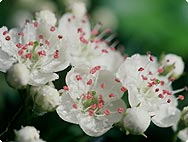
Crataegus monogyna JACQ. & laevigata (POIR.) DC
Hawthorn

History
Dioscorides mentioned hawthorn in his work in the first century AD. He called it krátaios, which is thought to derive from the Greek krátys ‘hard’ or ‘strong’, in reference to the plant’s hard wood. An alternative etymology associates the name with kratos, meaning ‘always having been here’. In the 3rd century BC, Theophrastus, one of Aristotle’s students, called it ‘kunosbatos’, leading to its inclusion in medieval herbal books (such as Lonicerus) under the name Cynosbatus Theophrasti. The species name monogyna means ‘monostylous’ (= single-seeded); laevigata means ‘smoothed’, and the older designation oxyacantha means ‘with pointed thorns’. The name ‘white thorn’ refers to its white springtime flowers. The ancient Teutons used the fruits of the hawthorn as a food, raw or cooked to a stew or mush. Its hard, reddish wood was used to make tools. Crataegus has often served as a motif in art. The portal of the Cathedral of Reims and one of the capitals in Naumburg Cathedral (both 13th century) are decorated with sculptures of the hawthorn leaves. These depictions and the common term for the plant, ‘Christ thorn’, bear witness to the legend that Jesus’ crown of thorns was twisted from hawthorn twigs. A famous specimen of hawthorn once blossomed in the cloister garden at Einsiedel. The tale is that it grew from a cutting that Duke Eberhard II of Wurttemburg brought back with him from the Holy Sepulchre in Jerusalem in the 14th century. This particular hawthorn was reputed to have miraculous powers and it is not surprising that flowering branches were arranged as protection against black magic. Jan Breughel the Elder depicted hawthorn branches in many of his paintings of flowers. The herbal books of the Middle Ages recommend hawthorn for stomach colics and diarrhoea. The first mention of its effect on the heart is by Quercetanus, the personal physician of King Henry IV of France, who concocted an ‘anti-age syrup’ from the plant. An Irish physician named Green helped it attain its wide reputation as a heart medication in the second half of the 19th century; since when it has had a firm place in the repertoire of plant medications.

Botanical Characteristics
The monostyle (single seed) hawthorn is a very branchy, small bush to medium-sized tree with thorny branches. The latter bear oval to rhombic, deeply and three- to five-lobed, dark green leaves. The flowers have five white to pink petals and one pistil. They are arranged in cymes. In the autumn or Fall, they form brilliant red, ovate to spherical berries (pseudocarps), 4mm to 8 mm in diameter and 6 mm to 10 mm long. The mealy, yellowish flesh contains a pip. The end of the berry has a small dimple, around which the remains of the five corolla tips can be seen. The di-style (double seed) hawthorn is very similar. But its leaves are only three-lobed and display rounded, serrate sections. Its flowers have two to three pistils and the berries have two to three pips. The two species cross readily and are thus difficult to distinguish. The hawthorn flowers from May to June. Other species of hawthorn, some of which are also used in medicine, include C. azarolus L., Azaroldorn, with yellowish-orange fruits; C. nigra, the black-fruited hawthorn; C. pentagyna, the pentastylous or five-pistilled hawthorn, with dull, dark purple fruits; and C. laciniata, the oriental hawthorn, with small, pear-shaped, red fruits.

Habitat
The hawthorn grows primarily at the edges of brush, in sparse deciduous forests, and in thickets up to 1500 metres in elevation. It is often planted as a hedge. Hawthorn is native to Central Europe but the species C. monogyna is widespread in North Africa and South-west Asia.

Preparation
A.Vogel produces an original tincture and a wine maceration from the fresh berries of C. monogyna and C. laevigata. The original/mother tincture contains an average of 552mg oligomere procyanidine and 813mg total phenol, both calculated as epicatechin. Determination of content takes place with the Folin-Ciocalteu reagent with phytometric measurement. The flavonoid content is ascertained only qualitatively. Phyto standardisation is achieved by mixing various batches. The indicated daily dose of 90 drops (=2.5ml) corresponds to a content of 14.2mg procyanidine. The dried leaves with or without flowers are often used to make tea. Homeopathic medicine uses preparations made from various parts of the plant. The berries can be used to make jam, compote, or brandy.
A.Vogel Blog – Natural and Healthy
Inspiration for a healthy life!
HERBAMARE SOUP-ER SOUPS!
DOWNLOAD YOUR FREE RECIPE BOOKLET!
8 healthy, hearty and delicious homemade soups.
Supporting a healthier happier you
“Nature is just about the best thing we’ve got!“
Alfred Vogel's guide to leading a healthy and happy life
Healthy & nutritious dinner ideas
Get new recipes in your inbox every month. Sign up now